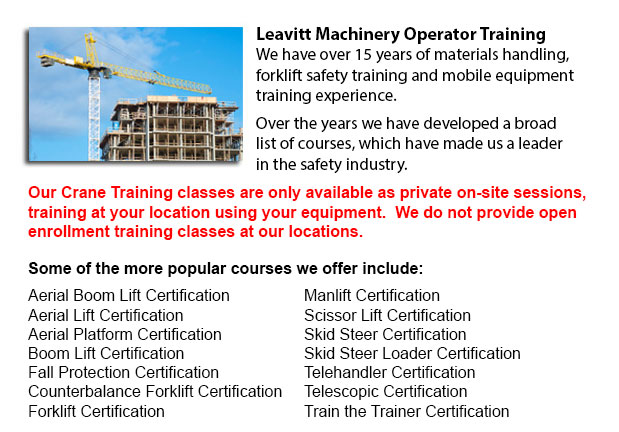
Vernon Crane Certification - The Crane Certification training program covers subject matter recommended by industry regarding the safe and efficient operation of cranes. People training will learn the following: how to identify cranes and their component parts; pre-operational, operational and post-operating requirements; rigging components and inspection/rejection criteria; how to determine overall lift capacity; and needs particular to the work site where the trainees will be working.
The requirements which should be carried out prior to operating a crane like for instance assigning authority for the pre-operational check; doing the sequential pre-operational check based on the specifications certified by a professional engineer or manufacturer's specifications; checking the log book for comments; inspecting the work place for hazards and obstacles; inspecting cables, hooks, chains safety latches and crane movement; ensuring the right functioning of operational controls; and knowing how to ensure the disconnect switch/isolator of the crane is working properly.
The requirements to operating a crane will include the identifying of responsibilities and roles, and the determination of the need for a formal lift plan. The individual training will be taught how to do hazard assessments for the different environmental circumstances, physical conditions and workers. Subject matter includes determining when to seek competent assistance, the destination of loads and the safest route, and centre of gravity and load weight.
It is vital for trainees to be able to identify an over-capacity lift, choose appropriate rigging machine, know load limits, and determine a safe position from which to work. Trainees would review both site-specific and universal crane signals for lifts, and techniques for lifting, loading and traveling. Appropriate maintenance practice will likewise be included.
Trainees will be evaluated on their knowledge of the need for emergency response procedures for different situations like for example an electrical or mechanical failure. They would be asked to describe parking and shut down procedures for security and safety, to follow tagging and lock out techniques, and to explain why near misses are recorded and reported to the right person. Log book records should be maintained.
The individual training will be taught the particulars of rigging, and know the responsibility and authority for rigging. They will learn to identify the various kinds of rigging, storage procedures and the load capacity ratings.
The requirements after operation of the crane would be taught also, learning to enter the deficiencies and defects; and to log the history of service and maintenance records, in accordance to the provincial, federal and state codes requirements.
Site-specific requirements could be incorporated into the safety training program based on the employer's needs.
-
Vernon Heavy Equipment Training Programs
Vernon Heavy Equipment Training Programs - At whatever given construction site, there are often different types of machinery which are ready to be used. These heavy and light machines need both operators to run them and mechanics to fix them. Trainee... More -
Vernon Forklift Safety Training
Vernon Forklift Safety Training - People wanting work in industries that operate lift trucks should undergo a forklift safety training program before becoming a certified operator of a lift truck. There are a lot of ways to go about acquiring forklif... More -
Vernon Aerial Boom Lift Ticket
Vernon Aerial Boom Lift Ticket - Aerial platform lifts can accommodate various odd jobs involving high and tough reaching places. Normally used to complete regular preservation in structures with tall ceilings, prune tree branches, elevate heavy shel... More -
Vernon Manlift Safety Training
Vernon Manlift Safety Training - Manlift operators need to be cognizant and aware of all the potential dangers which are associated with particular classes of scissor lifts. They need to be able to operate the scissor lift in a way that protects not... More -
Vernon Forklift License
Vernon Forklift License - Obtaining a forklift certification or forklift license in North America will require the one training to carry out hands-on training in addition to classroom instruction. The provincial, federal and state regulatory bodies a... More -
Narrow Aisle Forklift, Order Picker, Electric Pallet Jack, Electric Pallet Truck Certification in Vernon
A pallet lift is a model of equipment dedicated in the transporting of pallets of many dimensions and weights. They can be utilized as an appendage for forklifts, cranes and other styles of heavy machinery or be applied on their own. Pallet hoists ar... More -
Vernon Boom Lift Safety Training
Vernon Boom Lift Safey Training - Boom lifts are a type of elevated work platform or aerial lifting device which are commonly utilized in construction, industry, and warehousing. Boom lifts can be utilized in practically any surroundings because of t... More -
Vernon Manlift Operator Training
Vernon Manlift Operator Training - The aerial lift or manlift is a specialized kind of hydraulic platform that is designed to lift a person vertically giving it an alternate name of a vertical personnel lift. These machinery are widely utilized for a... More

Forklift Certification Vernon
TOLL FREE: 1-888-254-6157
Vernon, British Columbia
forkliftcertificationvernon.com
Email Us
About Us


